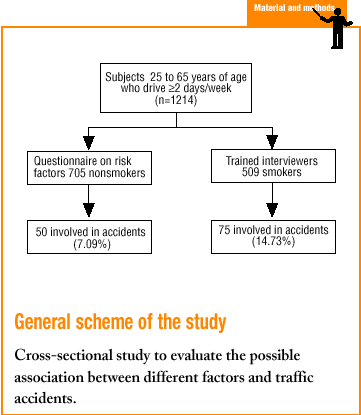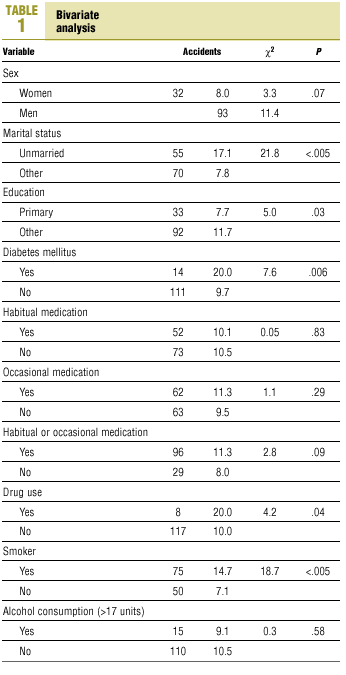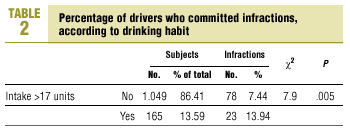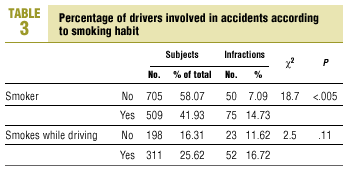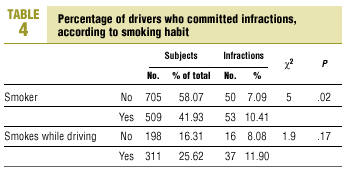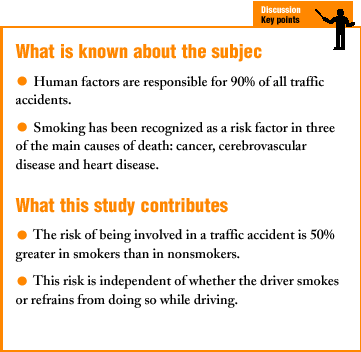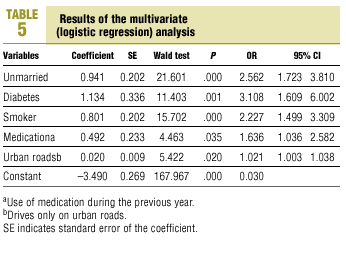Introduction
Traffic accidents are a current health problem. The figures for traffic accidents for the entire European Community are alarming:1 every year 50 000 persons are killed and 1 500 000 are injured. According to Prada, et al (1995),2 1.6% of the Spanish population had a traffic accident in 1993, and of all persons involved, 0.98%, or 5600 persons, were killed as a result.3
Driving a motor vehicle is a complex activity in which the driver becomes an information processor, receiving, evaluating, deciding and acting. Because these processes take place in very brief time periods, it is important for all pschophysical functions to perform optimally. Factors such as tiredness, fatigue, drinking, and certain drugs can alter the decision-making process, increasing the risk of accidents.
A number of studies have investigated the factors that influence traffic accidents, and human factors have been shown to be responsible for 90% of them.4 Although smoking is a recognized risk factor for the three main causes of death (cancer, cerebrovascular disease and heart disease), little attention has been given to smoking as a risk factor for accidents,5 another major cause of death. However, smoking has been identified as a cause of fires, explosions, and other fire-related accidents. One study related smoking with an increased risk of being involved in a traffic accident. Sacks and Nelson6 reviewed the relationship between smoking and different types of accident, and found that smokers had a 50% higher risk of traffic accidents than nonsmokers.7 A study of Montreal drivers involved in traffic accidents found that involvement was more often associated with smoking while driving than with age, sex or distance driven.8 Among participants in a safety course, smokers had 50% more accidents than nonsmokers; this difference persisted after adjustment for age, years of driving, and drinking.9,10 According to these findings, smoking may be an independent risk factor for being involved in traffic accidents. The aim of the present study, which forms part of a large-scale research project, was to investigate the association between smoking and nonfatal traffic accidents.
Material and methods
This cross-sectional study of associations was designed to evaluate the possible relationship between a number of factors and traffic accidents, by examining the prevalence of accidents according to exposure. On the basis of data obtained from the 1997 National Health Survey we calculated a sample size of 1246 questionnaires. The setting was the population of the city of Zaragoza in northeast Spain, and we selected for participation 8 health centers located in different parts of the city, from among the city´s 27 centers. A total of 1250 patients participated; 36 questionnaires were later excluded because of hard-to-understand, incomplete or contradictory data.
Patients
The subjects were men and women aged 25 to 65 years who came to any of the participating health centers and who drove on at least two days of the week.
Survey
We designed a questionnaire that was based on similar, previously standardized instruments, and trained a group of interviewers to ensure concordance between interviewers in implementing the survey. The following variables were recorded: 1) Sex and age: between 25 and 65 years inclusive. 2) Marital status: a) unmarried; b) married (or living with partner); c) separated (or divorced), d) widow or widower, and e) other. 3) Educational level, recorded as the highest level reached: a) primary; b) secondary; c) technical; d) university, or e) no formal education. 4) Profession: recorded as the participant´s profession at the time of the survey. 5) Disease: recorded as the most common chronic diseases that might influence motor vehicle driving. 6) Prescription and nonprescription drugs: recorded as habitual prolonged or continued) or occasional (sporadic or short-term) use of medications during the previous 12 months. 7) Drinking: recorded as weekly alcohol intake in standard units. For this study the participants were divided into two groups: those who consumed more than 17 standard units per week and those who consumed ¾17 units. 8) Use of illegal drugs: recorded as consumption during the previous 12 months and driving immediately after consumption. 9) Smoking: smokers were considered those participants who smoked any number of cigarettes daily during the previous year. The number of cigarettes smoked per day was noted, as was whether the participant smoked while driving. 10) Driving habits: recorded as the number of kilometers driven per week, and as driving on urban or interurban roads. 11) Accidents: recorded as accidents that had occurred during the previous 12 months, according to the definition published in the Boletín Oficial del Estado (BOE) no. 47, 24 February 1993. This source defines traffic accidents as unforeseen events that fulfil the following conditions: 1) Occurring or having their origin on any of the roadways subject to legislation regarding traffic, motor vehicle movement and traffic safety. 2) Giving rise to any of the following consequences: a) one or more persons killed or injured, and b) property damage only. 3) Involvement of at least one moving vehicle. Participants who had had an accident were asked whether anyone had been injured or killed, or whether the accident had resulted only in property damage. We assumed that if there were victims, property damage had also occurred. During the interview we asked participants only about injuries or deaths. 12) Reports to the police: recorded as infractions committed during the previous 12 months while the vehicle was in motion.
Data collection
After the interviewers had been trained, participants were interviewed during July, August and September 2001. All data were recorded in a database created in Microsoft Access.
Statistical analysis
The dependent variables in the statistical analysis were antecedents of being involved in an accident and reports to the police of infractions with the vehicle in motion during the previous 12 months. Both were recorded as dichotomous variables. The main independent variable was smoking. Bivariate analysis was first done with dependent and independent variables grouped into the following categories: general (sex, age, unmarried or otherwise, primary schooling or other), health problems, habitual or occasional use of medications, and risk habits (use of illegal drugs, smoking and drinking). When the independent variable was qualitative in nature, we used the chi-squared test. For quantitative independent variables we used Student-Fisher´s t test. Multiple logistic regression analysis was used to estimate the effect of independent variables on the dependent variable. Independent variables found in the bivariate analysis to have an association at a level of significance of <0.20 were considered covariables to control for. Variables were included according to a forward step-wise strategy, with the Wald test as the inclusion criterion. All results were expressed as odds ratios and 95% confidence intervals (95% CI). The statistical analysis was done with a database designed for Microsoft Access, and statistical tests were run with the SPSS package.
Results
In all, 1214 drivers were surveyed, of whom 125 (10.2%) had been involved in at least one accident during the previous 12 months. Injuries or deaths occurred in 22.4% of the accidents. Slightly more than two-thirds of the sample (67.3%) were men, 11.41% of whom had had one or more accidents, versus 8.02% of the women (χ2, 3.3; P=.07) (Table 1). Of the men who had been involved in accidents, 11.4% had committed a traffic infraction, versus 2.76% of the women (χ2, 24.1; P<.005). The differences between men and women were significant in both cases.
The greatest percentages of accidents involved younger drivers, with 20% of all accidents involving drivers aged 25 to 29 years. Mean age was significantly younger among drivers who had had accidents (mean, 40.2 years; SD, 11.4 years) than among drivers who had not been involved in accidents (mean, 43.8 years; SD, 12.0 years), with a t value of 3.2 (P=.002). More than two-thirds of the participants (69.69%) were married. The proportion of participants involved in accidents was larger for unmarried drivers (17.1%) than for all other groups (7.8%; χ2, 21.8; P=.005).
We found that 13.59% of the drivers drank more than 17 units of alcohol per week. Of these drivers, 9.09% had had an accident during the previous year. In the group of drivers who drank fewer than 17 units per week, 10.49% had had an accident during the previous year; the difference between the two groups was not significant (χ2, 3.0; P=.08). However, the number of infractions committed differed significantly between the two groups, as shown in Table 2.
The percentage of smokers in the sample was 41.93%. Of this group, 61.1% (n=311) admitted to smoking while they drove (Table 3). The percentage of drivers involved in accidents was 50% higher among smokers than among nonsmokers, and was even greater among smokers who smoked while driving, with a significant difference between smokers and nonsmokers. Although the percentage of accidents was higher among those who smoked while driving than among smokers who refrained from doing so, this difference was not significant (Table 3). With regard to the number of infractions, we also found that significantly more police reports had been filed against smokers than against nonsmokers. When we compared drivers who smoked with drivers who refrained from smoking at the wheel, we found that the difference between these two groups did not reach statistical significance (Table 4).
Discussion
Because of the nature of this study, we cannot claim that any of these variables is a direct cause of traffic accidents, although we can speak of significant or nonsignificant associations between variables. When an association denoting causality is strong, the variable in question is likely to be a causal factor. As in most known studies, we also found that mean age of drivers involved in accidents was lower than among drivers who had not had an accident. Antecedents of involvement in an accident were more frequent among men, drivers younger than 45 years, unmarried persons, and persons with secondary or university level education, as earlier research has also noted.2 Habitual drinking did not appear to be influential as a risk factor for traffic accidents. Driving under the effects of alcohol was related less clearly with accident rates, but more clearly with the seriousness (fatal outcome) of accidents. In Spain, high blood levels of alcohol have been found in 50%-55% of the persons who died in traffic accidents, and in 35.4% of the victims the concentration was greater than 0.8 g/L.11 At least 40% of all deaths from traffic accidents were caused directly by drinking, and the annual number of deaths from this cause has been placed at 2500.12 Habitual drinking unconnected with driving did not appear in the present study to be related with less serious, nonfatal accidents; however, this finding does not contradict the fact that drinking may be related with fatal accidents or accidents that result in severe disability. In fact, a weekly intake of more than 17 units of alcohol was related with a higher risk of being reported by the police for committing an infraction.
We found that in smokers the risk of having a traffic accident (odds ratio) was 2.22 (95% CI, 1.49%-3.09%) after adjustment for confounding variables such as age, marital status and level of education (Table 5). In other words, on average the risk of having a nonfatal traffic accident was twice as high among smokers as among nonsmokers. The proportion of drivers who were involved in accidents was 7.09% among nonsmokers, 11.62% among smokers who refrained from smoking at the wheel, and 16.72% among smokers who smoked while driving. The risk was therefore higher among smokers who smoked at the wheel than among smokers who did not smoke while driving (although the difference between these two subgroups was not statistically significant). Our findings are basically similar to those of other authors who reported an odds ratio of 1.51 after confounding variables such as sex, age, use of safety measures, occupation and cardiovascular risk had been controlled for.6,13 Other studies found an odds ratio of 1.5 for smokers in general and 2 for those who smoked while driving.10
Several reasons can be suggested for the higher risk of accidents in the latter subgroup, which may appear surprising: 1) Greater number of distractions during driving: smoking creates many potential sources of distraction, e.g., lighting a cigarette, not being able to use both hands for driving, eye irritation by smoke, etc. 2) Different behavior of drivers (probable tendency to take more risks). 3) Direct toxic effects of carbon monoxide (CO), which reduces alertness and attentiveness. One study has related increased levels of carboxyhemoglobin with reduced night vision, which may lead to driving errors.64) Medical problems associated particularly with acute cardiovascular disease. In England, insurance companies consider at least 5% of all traffic accidents to be directly or indirectly attributable to smoking inside the vehicle.
There is thus sufficient evidence that habitual smoking may imply a greater risk of traffic accidents. It is probably associated more closely with nonfatal than with fatal accidents, in contrast to the situation with regard to drinking. The risk associated with smoking probably results from the effects of chronic CO intoxication rather than the indirect effect of smoking-related distractions during driving. The problem thus will not be solved by legislative measures (such as making smoking while driving illegal), but instead will require educational measures and aids for smokers who wish to quit. This should be considered one reason more among the hundreds of good reasons for smokers to quit, and for health professionals to help them to do so.
Correspondence: José Miguel Buñuel Granados. C/ Cervantes, 26, 5.º C. 50006 Zaragoza. España. E-mail: jbunuelg@medynet.com
Manuscript received 26 April 2002.
Manuscript accepted for publication 25 November 2002.







